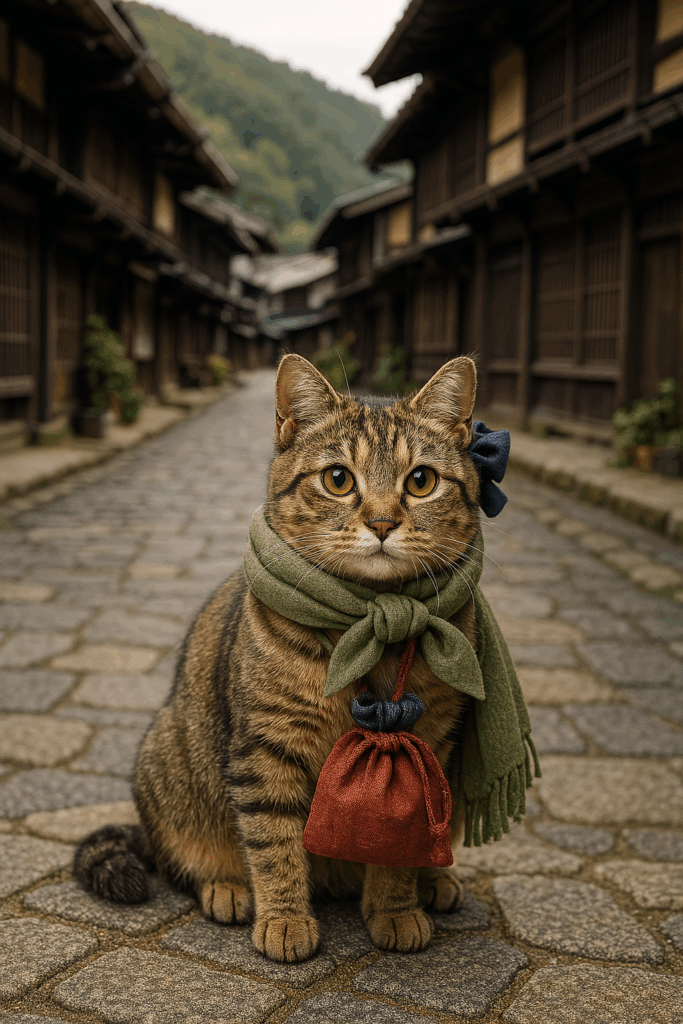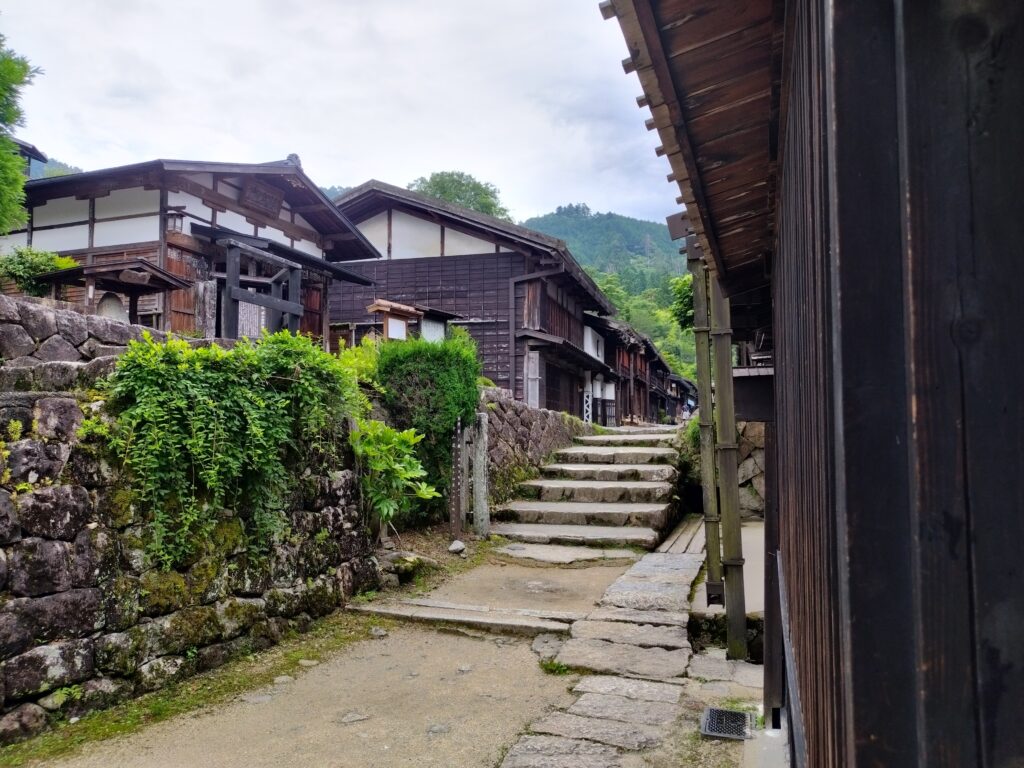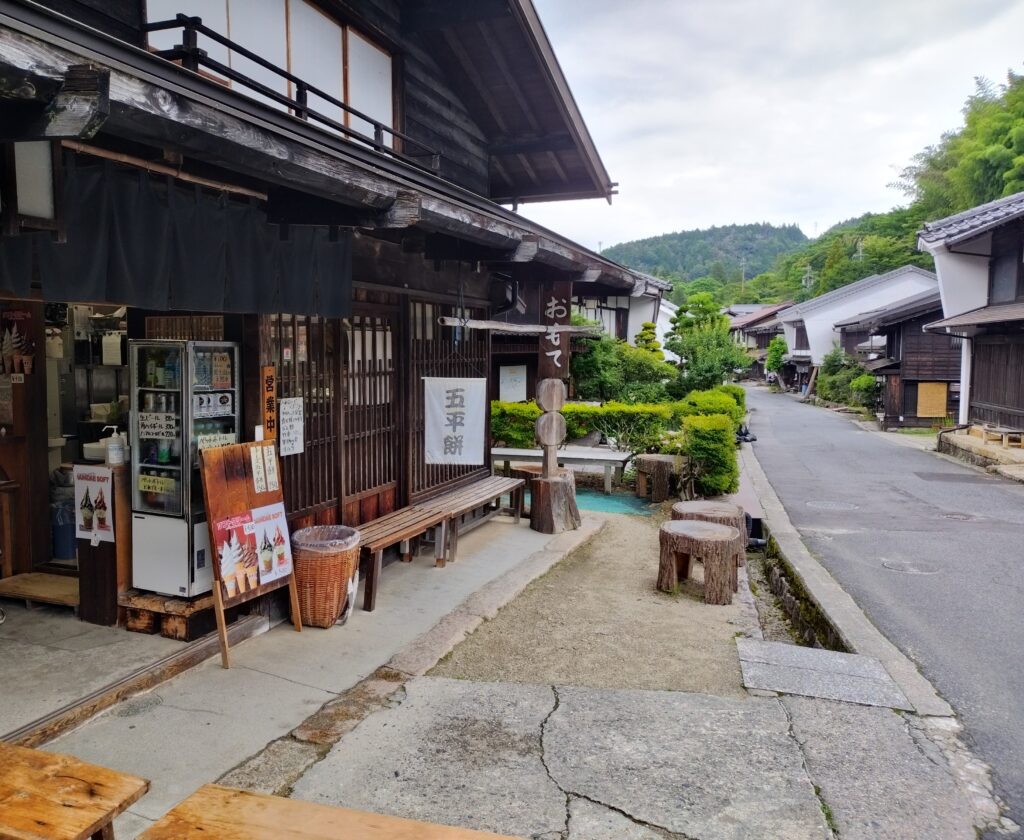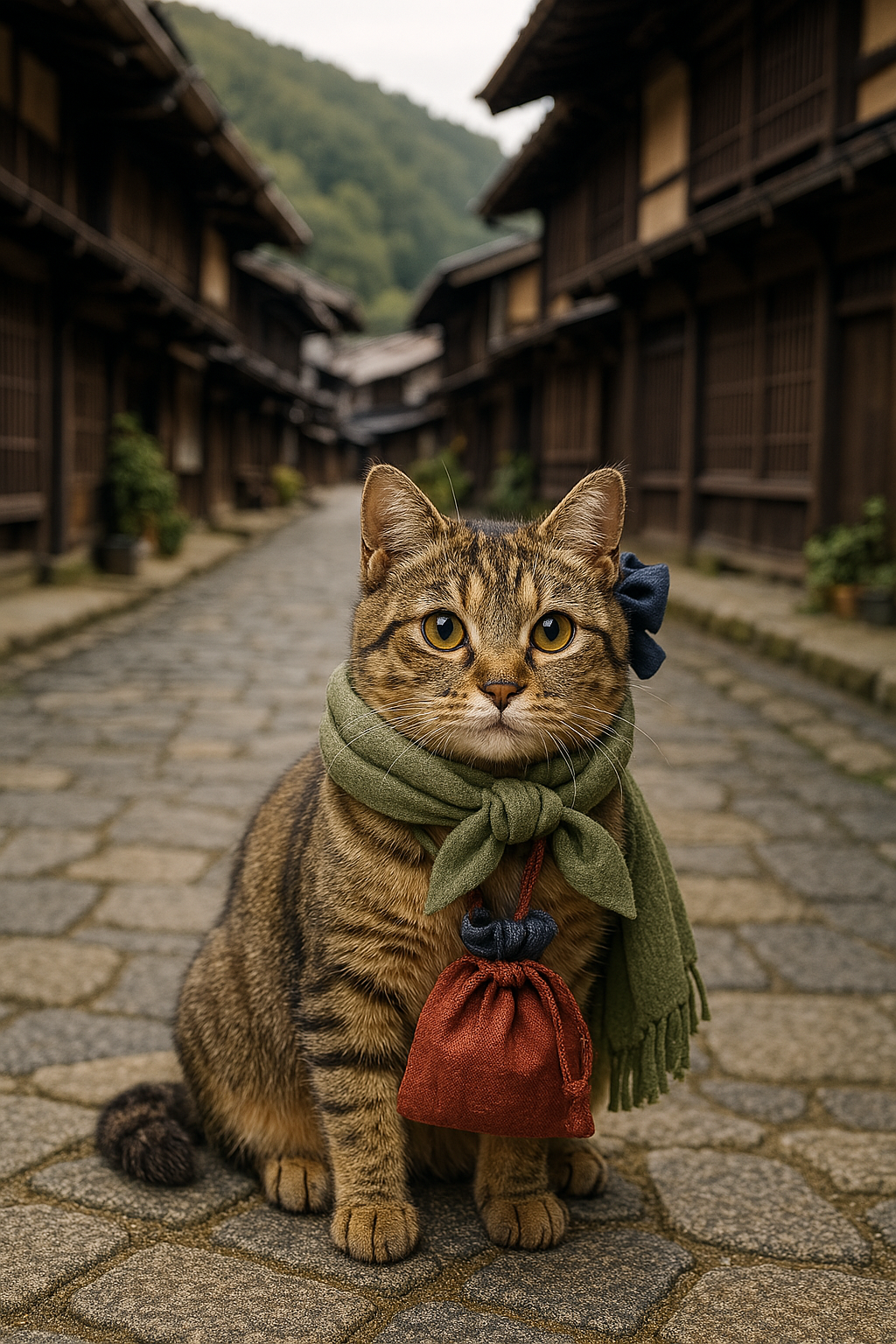本ブログは観光業、企業接待、留学生対応等で英語案内が必要ながら、多忙で準備に時間をかけられない方々の為にすぐに使える情報を分かりやすく解説しています。👉『これは何?』シリーズでは一般的な訪日外国人に興味のない情報(地名、名前、年代、専門用語等)は極力抑えて、相手の関心に合わせた英語説明力アップを目指していますので、詳細で高度な表現をお求めの方は各種公式or専用サイトをご参照下さい。
今回は商談で訪日中の重要顧客と移動中のハイヤーの中で、ネットで見た「妻籠宿(つまごじゅく)」について一体何かを聞かれ、その僅かの間に、できるだけ腑に落ちる回答をしたいシチュエーションです。
一般的に多くの訪日外国人は『食べ物』『アート』『建築(匠)』『ファッション』『日本人』に高い関心があると言われますので、それらの視点に立って、より口頭で短く、わかりやすくお伝えして、ぜひ「妻籠宿」を体験してみたい(行ってみたい)と思わせたいですよね。
1. この一言で腑に落ちる?
このパートのいずれかのワンフレーズでご納得いただけたらラッキーですね。もしだめなようでしたら、次のパートもお試しください。いつも通り、日本語で言えないことは英語でも言えませんので、日本語>英語順でご紹介します。
1.1 何百年前の旅人気分そのもの?

- 妻籠宿は、近くの馬籠宿とともに、侍の時代の宿場町の雰囲気を今に残す人気の観光地です。馬籠宿よりもさらに静かで落ち着いた雰囲気があります。まるで何百年も前に旅人が感じたように、時をさかのぼったかのような感覚を味わえます。
- Tsumago-juku, along with the nearby Magome-juku, is a popular tourist spot that preserves the atmosphere of an old post town from the samurai era. It has an even quieter and more peaceful feel than Magome-juku. Walking through Tsumago-juku truly feels like stepping back in time, just as travelers did hundreds of years ago.
- 👉先ずはオーソドックスな基本情報ご紹介パターンで、いつものお相手の反応見ながら選べる3段階構成です。
1.2 サムライの道を冒険かノンビリで?


- 妻籠宿は、「サムライ・トレイル」( サムライの道)沿いの歴史ある宿場町として、海外からの観光客に人気のスポットです。体力に自信があれば、スニーカーで隣の馬籠宿まで、8kmの山道を冒険気分で歩くこともできます。そうでなければ、妻籠宿の平坦な約1kmの旧町並みを、スリッパでのんびり散策するというリラックスした選択肢もあります。
- Tsumago-juku is a popular spot for overseas visitors, known as a historic post town along the “Samurai Trail” (also called the Samurai Road). If you’re physically fit, you can take an adventurous route in sneakers over the 8-kilometer mountain pass to neighboring Magome-juku. If not, you can opt for a more relaxing stroll in slippers through the flat, 1-kilometer stretch of Tsumago-juku’s old townscape.
- 👉もう一つのオーソドックス(トレンド反映型)パターンで、視覚に訴えてみました。
2.次の補足でご納得?
残念ながら前パートで外した場合のフォローセリフ、いつも通りインバウンド視点を踏まえ関心別に置いてみました。また色々な表現を織り込む為、全体的にかなり長くなってますので、お気に入りのフレーズあれば現場でも試してみる、そんな軽いノリでご利用ください。
2.1 建築(匠:たくみ)系
👉天皇,貴族,大名領主が泊まった建築物?


- 妻籠宿は、建築に興味のある人にとっては見逃せない場所です。武士の時代の宿場町の姿が、ほぼ当時のまま残されています。たとえば、天皇や貴族、地元の大名といった上流階級が、どのような宿泊施設に滞在していたのか。そして、お金のない庶民はどうだったのか――そうした違いも建物を通して垣間見ることができます。当時の宿泊施設におけるもてなしのレベルは、それぞれの建築に色濃く表れているのです。
- Tsumago-juku is a must-see for architecture enthusiasts, as it preserves the original townscape from the samurai era almost exactly as it was. You can glimpse what kinds of accommodations were provided for the upper class—such as emperors, aristocrats, and local lords—as well as how ordinary travelers of more modest means were hosted. The varying levels of hospitality are still visible today through the architecture of each lodging facility.
- 👉多くのインバウンドに本陣、脇本陣(本陣の補助的存在)の用語はそれほど重要でないので、そこは現場で適当に。


2.2 ファッション系
👉「タイムスリップ」「和の風情」が背景の写真?

- 妻籠宿では、「タイムスリップ」や「和の風情」をテーマに、おしゃれな写真を撮ることができます。お店でスカーフ、巾着袋、和風のヘアアクセサリーなどを見つけたら、普段着にプラスしてみてください。茶色、ベージュ、深緑、藍色といった落ち着いたアースカラーや伝統的な和の色を選べば、木造の建物や石畳の通りにも自然になじみ、風景に溶け込んだ素敵な写真が撮れるはずです。
- In Tsumago-juku, you can snap stylish photos with a “time-slip” or “Japanese flair” theme. Just pick up a scarf, drawstring pouch, or traditional-style hair accessory—if available—from a local shop and add it to your everyday outfit. Earthy tones and classic Japanese colors like brown, beige, moss green, or indigo pair beautifully with the wooden buildings and cobblestone streets, helping you blend seamlessly into the scene and look fantastic in every photo.
- 👉妻籠の控えめな露出に合わせて今回はファッションネタも控えめにしました。
2.3 アート系
👉妻籠宿そのものがアート作品?

- 妻籠宿は、プロの芸術家に頼ることなく、住民たち自身の創意工夫と試行錯誤によって形作られた芸術作品と言えるでしょう。武士の時代が終わると、この宿場町は鉄道による近代化の波から取り残され、まるでゴーストタウンのようになってしまいました。しかし、住民たちは故郷を完全に修復するために、持てるものすべてを注ぎ込みました。その結果、生きた風景画のような町並みが生まれ、人々は中に入り、歩き回りたくなるのです。
- Tsumago-juku can be seen as a work of art crafted by its own residents through ingenuity and trial and error, without relying on professional artists. After the end of the samurai era, the post town became almost like a ghost town, left behind by modernization and the spread of the railway system. Yet the townspeople devoted nearly everything they had to fully restore their hometown, creating a living landscape painting that makes you want to step inside and wander through it.
- 👉実際にここでは歩くことがメインアトラクションなので。
2.4 フード系
👉妻籠宿ならではの味を楽しめるかも?

- 妻籠宿では、地元のソウルフードである五平餅と朴葉餅がおすすめです。五平餅は、軽くつぶしたご飯を平たい串に刺し、くるみやごま、醤油、味噌などを使った甘辛い特製のタレを塗って香ばしく焼き上げたものです。朴葉餅は、朴の葉で包んで蒸した餅で、葉の清々しい香りが餅に移り、独特の風味を生み出します。中には基本的にあんこが入っていますが、作り方は地域や店ごとに少しずつ異なり、妻籠宿ならではの味を楽しめるかもしれません。
- In Tsumago-juku, gohei-mochi and hoba-mochi—beloved local soul foods—come highly recommended. Gohei-mochi is made from lightly mashed rice formed onto flat skewers, coated in a sweet and savory sauce made from ingredients like walnut, sesame, soy sauce, and miso, then grilled until fragrant and golden. Hoba-mochi are steamed rice cakes wrapped in magnolia leaves, which infuse the mochi with their fresh, earthy aroma and distinctive flavor.While they are typically filled with sweet red bean paste, the recipe and preparation vary subtly by region and shop—so you’re likely to discover a flavor unique to Tsumago-juku.
- 👉欲張って両方入れましたが、餅ろん(勿論!)お相手の好み(甘党?辛党?)に合わせて一方でもOKですよね。
2.5 日本人系
👉サムライ時代の日本人の「用の美」がわかる?

- 妻籠宿では、日本人が追い求めてきた「実用性」や「用の美」、そして細部にまで宿る丁寧な職人技を随所に感じ取ることができます。たとえば、二階の正面が通り側にせり出した「出梁造(でばりづくり)」や、隣家との境界を区切る「うだつ」などが挙げられます。これらの建築様式は、限られた敷地の中で空間を確保したり、延焼を防いだりといった実用的な目的を果たす一方で、町並みに独特のリズムや控えめな美しさを与えています。機能と美が切り離されることなく共存していた武士の時代の設計思想を、妻籠宿では今もなお肌で感じることができるのです。
- In Tsumago-juku, visitors can appreciate Japan’s pursuit of practicality and functional beauty, as well as the meticulous craftsmanship found in even the smallest details.Take, for example, the debari-zukuri style, where the front of the second floor juts out over the street, or the udatsu, a raised partition marking the boundary between neighboring houses.While these architectural features serve practical purposes—like maximizing space on narrow plots or preventing the spread of fire—they also lend a unique rhythm and understated elegance to the townscape. Tsumago-juku offers a rare glimpse into the samurai-era ideal, where function and beauty were never separate but intimately entwined in everyday design.
- 👉今回の日本人ネタは建築ネタとなりました。(実際に質問もされる)建築表現をふたつ置きましたので、簡単に答える際のご参考にもなればと思います。
御礼&後書き
お忙しい中、今回も最後までご覧いただき大変ありがとうございました。今回テーマ含め今後も定期的にブラッシュアップして参りますので、引き続きご参照のほど宜しくお願い致します。🔶Gold🔶R70705.v.5b.5b.5b/+


